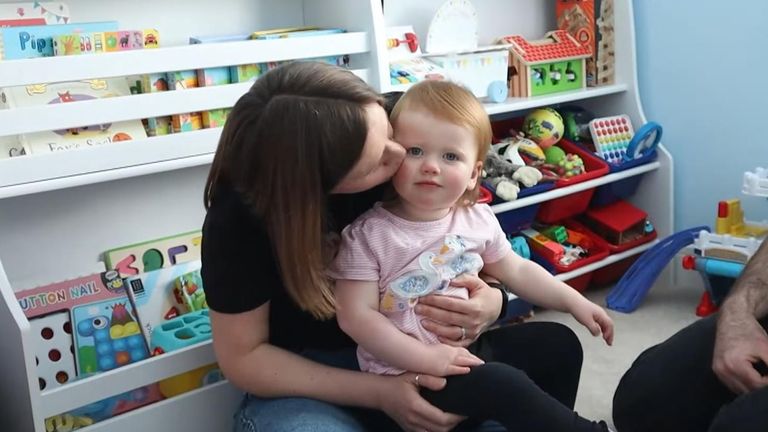England’s first artificial cornea transplant hailed a success | UK News

A 91-year-old man has become the first person in England to be fitted with a ground-breaking artificial cornea.
Cecil ‘John’ Farley, 91, said his sight was now improving thanks to the procedure, which he underwent after 15 years of suffering from problems with his eyes.
The cornea is the clear outer layer at the front of the eyeball – and is described by the NHS as the “window to the eye”.
A person can suffer from vision problems and pain if the thin transparent covering is damaged by disease or injury – with those affected often left facing a long wait for a human transplant.
However, it is hoped that the artificial device, called EndoArt, will slash waiting times, ease pressure on the NHS and eliminate the risk of the human body rejecting corneas received from an organ donor.
Mr Farley, from Chobham in Surrey, said he was overjoyed by the transplant – in his right eye – because it meant he could continue to see his 83-year-old wife Elizabeth.
He said: “I can still see my wife after 63 years of marriage, we can just carry on as normal and live life as fully as we can.
“It makes your life fuller when your eyes work properly – you don’t realise how debilitating it is until it happens to you.”
Cecil Farley has his new cornea examined. Pic: PA
Before the surgery, Mr Farley had no vision in his right eye – but his sight has slowly been improving ever since the procedure in February.
He said: “It has made a great difference to my sight. It was very blurred and I couldn’t distinguish a face.
“Now I can see better with it, the brighter the light the better. It’s coming along slowly – they said it could take up to a year.”
The artificial cornea has been compared to a contact lens. The device, which replaces the inner part of the cornea, is surgically attached to the eye by a single stitch and is put in place with a gas bubble.
Patients could see major impact
One of the biggest advantages of using artificial corneas is the huge reduction in waiting time for the procedure. It means patients on the elective backlog who risk further deterioration in their vision can be seen months earlier than they would waiting for a cornea transplant from an organ donor.
But at the moment the artificial cornea operation can only be carried out on patients who meet the “complex eye” criteria. These include patients whose previous human cornea transplant has failed.
Consultant ophthalmologist Tom Poole, who carried out the procedure, is confident the surgery can be rolled out to “virgin eye” patients in the future. These are patients with no previous history of eye surgery.
Mr Poole told me the international ophthalmology community was growing increasingly confident with artificial corneas which are relatively easy to make and their production could be scaled up quite easily.
He and his colleague Hanbin Lee at Frimley Health NHS Foundation Trust have already carried out three more operations since February.
The latest tests on Mr Farley suggest the procedure has been a success. Three more patients have been identified and are listed for surgery.
Only 200 people worldwide, including Mr Farley, have been fitted with an EndoArt so far, but there are hopes it can be more widely rolled out.
Organic cornea transplants usually come from deceased donors. A total of 4,719 were donated to the NHS in 2022/23, according to the latest available figures.
Read more:
NHS nurses declare ‘national emergency’
‘Drunk’ woman diagnosed with rare condition
Rise in cancer rates in younger people
Consultant ophthalmologist Thomas Poole, from Frimley Health NHS Foundation Trust in Surrey, which carried out the procedure, described the artificial cornea as a “great advancement”.
He said there had been fears that Mr Farley was “kind of getting to [his] last hope” after a previous human transplant failed.

Thomas Poole with Mr Farley. Pic: PA
Mr Poole said: “I had a very frank discussion with him before and I said: ‘Look, your graft has failed, you’re back on the waiting list. Because your other eye sees quite well, you’re not a high priority on the waiting list and you could be waiting for another year’.
“He’s in his 90s now and said ‘I just can’t wait that long. Is there anything else?’ And so this sprung to mind.
“I had just read a publication on very good reports from this artificial graft and it was that that made me think actually, maybe we could use this for John.”

Cecil Farley said he was overjoyed he would be able to continue seeing his wife. Pic: PA
Mr Poole and his colleague Hanbin Lee have now successfully given four patients artificial corneas in the last two months and the initial results have shown an improvement in vision.
He added: “Looking forward to the future, I think this may end up replacing human corneas for certain types of corneal graft patients.
“In maybe 10 or 20 years’ time – this may become the norm where we don’t need a human cornea, and we can just take one out of the box.”

Keep up with all the latest news from the UK and around the world by following Sky News
Tap here
Please use Chrome browser for a more accessible video player

1:20
Deaf girl reacts to mother’s voice after hearing restored
Mr Farley, a former flooring company owner, said that once his sight is restored he hopes to do practical tasks like repairing a watch.
However, for now, he is content “pottering about”.

Recent Comments